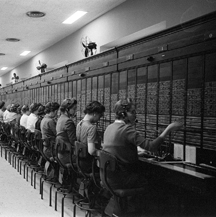Despite this progress, evidence suggests that many women remain unable to achieve their goals. The gap in earnings between women and men, although smaller than it was years ago, is still significant; women continue to be underrepresented in certain industries and occupations; and too many women struggle to combine aspirations for work and family.
Further advancement has been hampered by barriers to equal opportunity and workplace rules and norms that fail to support a reasonable work-life balance. If these obstacles persist, we will squander the potential of many of our citizens and incur a substantial loss to the productive capacity of our economy at a time when the aging of the population and weak productivity growth are already weighing on economic growth.
A historical perspective on women in the labor force
In the early 20th century, most women in the United States did not work outside the home, and those who did were primarily young and unmarried. In that era, just 20 percent of all women were “gainful workers,” as the Census Bureau then categorized labor force participation outside the home, and only 5 percent of those married were categorized as such. Of course, these statistics somewhat understate the contributions of married women to the economy beyond housekeeping and childrearing, since women’s work in the home often included work in family businesses and the home production of goods, such as agricultural products, for sale.
Also, the aggregate statistics obscure the differential experience of women by race. African American women were about twice as likely to participate in the labor force as were white women at the time, largely because they were more likely to remain in the labor force after marriage.
The fact that many women left work upon marriage reflected cultural norms, the nature of the work available to them, and legal strictures. The occupational choices of those young women who did work were severely circumscribed.
Most women lacked significant education—and women with little education mostly toiled as piece workers in factories or as domestic workers, jobs that were dirty and often unsafe. Educated women were scarce. Fewer than 2 percent of all 18- to 24-year-olds were enrolled in an institution of higher education, and just one-third of those were women. Such women did not have to perform manual labor, but their choices were likewise constrained.
And in 1974, women gained, for the first time, the right to apply for credit in their own name without a male co-signer.
Despite the widespread sentiment against women, particularly married women, working outside the home and with the limited opportunities available to them, women did enter the labor force in greater numbers over this period, with participation rates reaching nearly 50 percent for single women by 1930 and nearly 12 percent for married women. This rise suggests that while the incentive—and in many cases the imperative—remained for women to drop out of the labor market at marriage when they could rely on their husband’s income, mores were changing.
Indeed, these years overlapped with the so-called first wave of the women’s movement, when women came together to agitate for change on a variety of social issues, including suffrage and temperance, and which culminated in the ratification of the 19th Amendment in 1920 guaranteeing women the right to vote.
Read More
The Brookings Gender Equality Series







